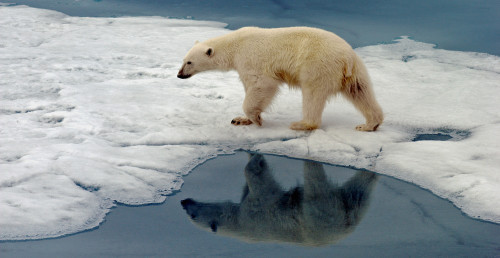Arctic spring melt has begun. Ice extent declined most substantially in the Bering Sea and the Sea of Okhotsk. Overall decline was slower than average through the month.
Overview of conditions
Average Arctic sea ice extent for April 2022 was 14.06 million square kilometers (5.43 million square miles) (Figure 1). This was 630,000 square kilometers (243,000 square miles) below the 1981 to 2010 average and ranked eleventh lowest in the 44-year satellite record. Extent declined slowly through the beginning of the month, with only 87,000 square kilometers (33,600 square miles) of ice loss between April 1 and April 10. The decline then proceeded at an average pace for this time of year through the reminder of the month. Reductions in sea ice extent during April occurred primarily in the Bering Sea and the Sea of Okhotsk. Other regions had small losses at most. The southern Barents Sea lost some ice, but the channel of open water north of Novaya Zemlya that persisted for much of the winter closed during April. Overall, the daily sea ice extent tracked just below the interdecile range (below 90 percent of past daily values) for the month.

Sea ice age
With the onset of spring, it is time again for a check-in on sea ice age—the number of years that a parcel of ice has survived summer melt. As noted in previous posts, ice age provides a qualitative assessment of thickness, as older ice has more chances to thicken through ridging, rafting, and bottom ice growth (accretion) during winter. The coverage of the old, thick ice has a significant control on how much total ice survives the summer melt season—the first-year ice that grows thermodynamically over winter is more easily melted away during summer. That which survives through the summer melt season grows in age by one year. The extent of old ice declines through the winter when it drifts out of the Arctic through the Fram or Nares Strait. At the end of last summer, the extent of the oldest ice (greater than 4 years old) tied with 2012 for the lowest in the satellite record. This spring, we continue to see a dominance of first-year ice (Figure 4). The percentage of the greater than 4-year-old ice, which once comprised over 30 percent of the Arctic Ocean, now makes up only 3.1 percent of the ice cover.

This map shows the age of Arctic sea ice for the March 12 to 18 period in (a) 1985 and (b) 2022. The oldest ice, greater than 4 years old, is in red. Plot (c) shows the timeseries from 1985 through 2022 of percent cover of the Arctic Ocean domain (inset, purple region) by different sea ice ages during the March 12 to 18 period. Credit: M. Tschudi, W. Meier, and Stewart, NASA NSIDC DAAC
![]() Please help keep us afloat. Donate here
Please help keep us afloat. Donate here







